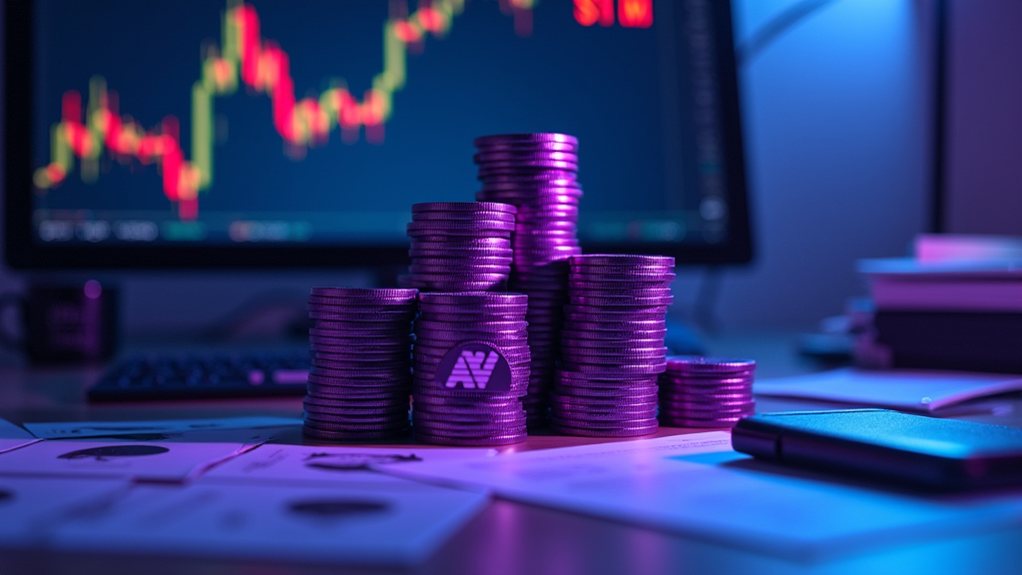Aurora represents a significant improvement in the NEAR Protocol ecosystem, offering EVM compatibility and improved scalability through its Nightingale sharding technology. The protocol facilitates seamless asset transfers via the Rainbow Bridge while maintaining near-zero transaction costs and 2-3 milliseconds finalization times. With its fixed supply of 1 billion AURORA tokens and innovative burning mechanism utilizing NEAR tokens, Aurora’s architecture demonstrates compelling potential for developers seeking efficient cross-chain solutions in decentralized finance.

Innovation in blockchain technology continues to expand as Aurora emerges as a groundbreaking solution within the NEAR Protocol ecosystem. Operating as an Ethereum Virtual Machine (EVM) compatible platform through NEAR’s smart contract infrastructure, Aurora facilitates the execution of Ethereum contracts while delivering improved performance metrics, including 2-3 moment transaction finalization times.
The platform’s integration with NEAR Protocol utilizes advanced sharding technology known as Nightingale, enabling superior scalability and efficiency compared to traditional blockchain networks. Through its trustless Rainbow Bridge, Aurora enables seamless asset transfers between Ethereum and NEAR, while maintaining compatibility with fundamental development tools like MetaMask, Truffle, and Hardhat, creating a familiar environment for Ethereum developers. Users enjoy near-zero transaction costs while conducting operations on the platform.
The AURORA token, launched in October 2021 with a fixed supply of 1 billion tokens, serves as the ecosystem’s governance mechanism, allowing stakeholders to participate in vital protocol decisions and upgrades. The token’s innovative burning mechanism, which utilizes NEAR tokens collected from transactions to buy back and burn AURORA, creates a deflationary pressure on the token supply, potentially improving its long-term value proposition. The platform distributes annual inflation rewards of 5% to its node operators, ensuring network security and stability.
Aurora’s ecosystem has demonstrated significant growth through its decentralized applications, with platforms like Trisolaris DEX and NearPad Launchpad contributing substantially to the network’s Total Value Locked (TVL). The platform’s commitment to environmental sustainability, inherited from NEAR’s carbon-neutral certification, positions it favorably among environmentally conscious investors and developers. Similar to Polkadot’s approach to blockchain connectivity, Aurora’s relay chain architecture enables efficient cross-chain communication and data exchange.
The technical architecture of Aurora addresses several key challenges in the blockchain space, combining the reliability of Ethereum’s smart contract functionality with NEAR’s high-performance infrastructure. By offering reduced transaction fees while maintaining EVM compatibility, Aurora provides a compelling alternative for developers and users seeking efficient blockchain solutions.
The platform’s integration of user-friendly features, including web wallets and human-readable addresses, further improves its accessibility and practical utility within the expanding decentralized finance landscape.
FAQs
How Does Aurora’s Gas Fee Structure Compare to Other Layer-2 Solutions?
Aurora’s gas fee structure differs from other Layer-2 solutions through its unique combination of using ETH for fees while maintaining constant pricing without auctions.
While Polygon employs its native token and Optimism follows Ethereum’s auction-based model, Aurora utilizes NEAR Protocol’s infrastructure to deliver consistent sub-penny transaction costs.
This approach enables Aurora to achieve up to 1,000x lower fees than Ethereum, with two-second finality.
What Are the Minimum Hardware Requirements for Running an Aurora Node?
Running an Aurora node requires specific minimum hardware specifications: 4 CPU cores for efficient processing, 8 GB RAM for operational functionality, and at least 100 GB of disk space for blockchain data storage.
The system must operate on Linux distributions, preferably Ubuntu or Fedora, with Docker installed for containerization.
Furthermore, a stable, high-speed internet connection is crucial for maintaining the required 24/7 uptime.
Can Aurora Tokens Be Staked Directly Through Hardware Wallets?
Aurora tokens cannot be staked directly through hardware wallets, as staking requires active participation in the network’s proof-of-stake mechanism.
While hardware wallets like Ledger can securely store AURORA tokens, the actual staking process must be conducted through compatible staking platforms or decentralized applications that interface with the NEAR protocol.
Here, users can delegate their tokens to validators while maintaining custody through their hardware wallet.
When Will Aurora Implement Cross-Chain Bridges With Other Major Networks?
Aurora has already implemented several cross-chain bridges, including the Rainbow Bridge with Ethereum and partnerships with Allbridge for Terra connectivity.
Future bridge developments are scheduled throughout 2024, including improved Bitcoin integration and NFT cross-chain capabilities.
The platform’s roadmap indicates new bridge announcements with major networks in the coming months, while leveraging NEAR’s sharding technology to boost cross-chain scalability and transaction throughput.
What Security Measures Does Aurora Use to Protect Against Smart Contract Vulnerabilities?
Aurora employs extensive security measures through regular smart contract audits, which examine vulnerabilities like reentrancy and unsafe external calls.
The platform implements both manual analysis and automated testing tools to verify contract functionality, while maintaining a robust bug bounty program for vulnerability detection.
Security protocols include strict access control mechanisms, systematic code updates, and thorough validation of mathematical calculations and token interactions within the smart contracts.









